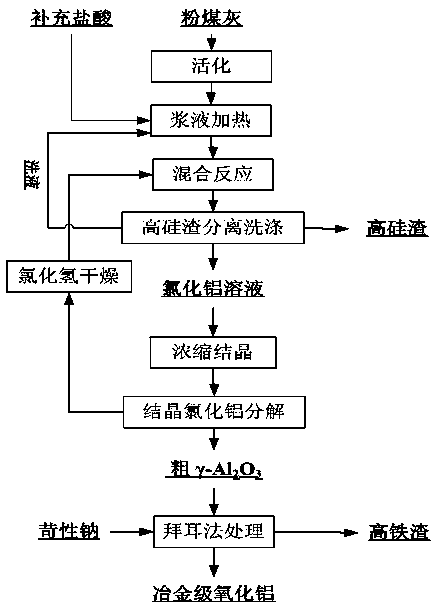Method for preparing aluminum oxide by using hydrochloric acid treatment coal ash
A fly ash, alumina technology, applied in the removal of alumina/aluminum hydroxide, solid waste, etc., can solve the problems of high energy consumption, hidden safety hazards for operators, secondary pollution, etc., to ensure the concentration of hydrochloric acid, avoid Corrosion hazard, beneficial effect on industrialization
- Summary
- Abstract
- Description
- Claims
- Application Information
AI Technical Summary
Problems solved by technology
Method used
Image
Examples
Embodiment 1
[0026] The fly ash is mechanically activated by a vibrating mill, and 5% concentration of supplementary hydrochloric acid and washing liquid are mixed with fly ash to form a slurry, which is indirectly heated to 160°C with saturated steam in an indirect heat exchanger and then sent to the lining for acid resistance The ceramic tile reactor is filled with hydrogen chloride gas recovered by drying concentrated sulfuric acid. The molar ratio of hydrogen chloride and the sum of HCl in the supplemental hydrochloric acid to the sum of alumina and iron oxide in the fly ash is 6.5, and the reaction time is 2 hours. Liquid separation to obtain aluminum chloride liquid. The solid-liquid separation of aluminum chloride solution and high silicon slag uses flocculation sedimentation. The aluminum chloride liquid is spray-dried to obtain crystalline aluminum chloride, and aluminum chloride crystals are decomposed at 400°C to obtain crude γ -Al 2 O 3 And hydrogen chloride gas, hydrogen chlorid...
Embodiment 2
[0028] The raw material fly ash in Example 1 is mechanically activated by a vertical mill, and 10% concentration of supplementary hydrochloric acid and washing liquid are mixed with fly ash to form a slurry, which is indirectly heated to 190°C with superheated steam in an indirect heat exchanger Then it is sent to the reactor lined with enamel, and the hydrogen chloride gas recovered by the drying of concentrated sulfuric acid is passed. The molar ratio of hydrogen chloride and the above supplementary hydrochloric acid to the sum of alumina and iron oxide in the fly ash is 7.5, and the reaction time 3h, after the reaction is cooled, solid-liquid separation is obtained to obtain aluminum chloride liquid. The solid-liquid separation of aluminum chloride solution and high silicon slag adopts flocculation sedimentation, and the aluminum chloride liquid is dried by drum to obtain crystalline aluminum chloride. Decompose at 500℃ to obtain crude γ-Al 2 O 3 And hydrogen chloride gas, hy...
Embodiment 3
[0030] The raw material fly ash in Example 1 is mechanically activated by a planetary mill, and 8% concentration of supplementary hydrochloric acid and the lotion are mixed with fly ash to form a slurry, which is indirectly heated to 200°C with heat transfer oil in an indirect heat exchanger and then sent Into a glass-lined reactor, pass the hydrogen chloride gas recovered by drying with concentrated sulfuric acid. The molar ratio of hydrogen chloride and the sum of HCl in the supplementary hydrochloric acid to the sum of alumina and iron oxide in the fly ash is 9, and the reaction time is 1h. After the reaction is cooled down, the solid-liquid is separated to obtain aluminum chloride liquid. The solid-liquid separation of the aluminum chloride solution and the high silicon slag adopts flocculation and sedimentation. The aluminum chloride liquid adopts forced circulation evaporation and crystallization to obtain crystalline aluminum chloride. The aluminum chloride crystal is 600 ...
PUM
 Login to View More
Login to View More Abstract
Description
Claims
Application Information
 Login to View More
Login to View More - R&D
- Intellectual Property
- Life Sciences
- Materials
- Tech Scout
- Unparalleled Data Quality
- Higher Quality Content
- 60% Fewer Hallucinations
Browse by: Latest US Patents, China's latest patents, Technical Efficacy Thesaurus, Application Domain, Technology Topic, Popular Technical Reports.
© 2025 PatSnap. All rights reserved.Legal|Privacy policy|Modern Slavery Act Transparency Statement|Sitemap|About US| Contact US: help@patsnap.com

